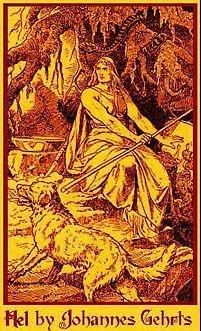Post by bluefedish on Jan 9, 2008 15:38:29 GMT -5
In Norse mythology, Hel (sometimes Anglicized or Latinized as Hela) is the ruler of Hel, the Norse underworld. Hel's hall is named Éljúðnir.
The old Old Norse word Hel derives from Proto-Germanic *khalija, which means "one who covers up or hides something", which itself derives from Proto-Indo-European kel-, meaning "conceal". The term may have later spawned the English word Hell. Related terms are Old Frisian helle, German Hölle and Gothic halja.
In the Prose Edda book Gylf*ginning, Hel is described as the daughter of Loki and Angrboða – a giantess (gýgr, see jotun) – and thus sister of the Fenrisulfr and the sea serpent Jörmungandr. Since her father is often described as a god, although both his parents were giants, the same might be said of Hel.
When Odin became aware of the existence of Loki's children, he banished them to remote places. He then cast Hel down to her realm in the underworld and gave her authority over all those in the nine worlds who do not die gloriously in battle but of sickness or of old age.
Appearance
She has great possessions there; her walls are exceeding high and her gates great. Her hall is called Sleet-Cold; her dish, Hunger; Famine is her knife; Idler, her slave; Sloven, her maidservant; Pit of Stumbling, her threshold, by which one enters; Disease, her bed; Gleaming Bale, her bed-hangings. She is half blue-black and half flesh-color (by which she is easily recognized), and very lowering and fierce. ~ Brodeur translation
The Realm of Hel
The path to Hel is known as the Helvegr and the gates Helgrindr or Nágrind ("Corpse Gate"). Here Garmr is fastened, Hel's watchdog, who is bloody both on chest and neck.
Late Description
It has been suggested that this description of Hel is of later date, and that she originally was a much more neutral goddess over the realm of shadows, where all, despite their deeds, gather after death. This can be seen as being supported by the etymology of Hel (Lat. Celāre, Ger. hehlen), meaning the "hider". It is important to note that also that Baldr and Sigurd are sent to Hel after their deaths. Bishop Wulfila uses the Gothic word Halja to translate the Greek "Hades."
Viktor Rydberg, in particular, advocated this view. In the book "Our Fathers' Godsaga" he theorizes that the correct name for Loki's daughter is in fact "Leikn" and that, in Christian times, she was confused with Urðr, one of the three Norns and the dís of fate and death. Rydberg's theories are not generally accepted.

Selected Source:
en.wikipedia.org/wiki/Hel_%28being%29
The old Old Norse word Hel derives from Proto-Germanic *khalija, which means "one who covers up or hides something", which itself derives from Proto-Indo-European kel-, meaning "conceal". The term may have later spawned the English word Hell. Related terms are Old Frisian helle, German Hölle and Gothic halja.
In the Prose Edda book Gylf*ginning, Hel is described as the daughter of Loki and Angrboða – a giantess (gýgr, see jotun) – and thus sister of the Fenrisulfr and the sea serpent Jörmungandr. Since her father is often described as a god, although both his parents were giants, the same might be said of Hel.
When Odin became aware of the existence of Loki's children, he banished them to remote places. He then cast Hel down to her realm in the underworld and gave her authority over all those in the nine worlds who do not die gloriously in battle but of sickness or of old age.
Appearance
She has great possessions there; her walls are exceeding high and her gates great. Her hall is called Sleet-Cold; her dish, Hunger; Famine is her knife; Idler, her slave; Sloven, her maidservant; Pit of Stumbling, her threshold, by which one enters; Disease, her bed; Gleaming Bale, her bed-hangings. She is half blue-black and half flesh-color (by which she is easily recognized), and very lowering and fierce. ~ Brodeur translation
The Realm of Hel
The path to Hel is known as the Helvegr and the gates Helgrindr or Nágrind ("Corpse Gate"). Here Garmr is fastened, Hel's watchdog, who is bloody both on chest and neck.
Late Description
It has been suggested that this description of Hel is of later date, and that she originally was a much more neutral goddess over the realm of shadows, where all, despite their deeds, gather after death. This can be seen as being supported by the etymology of Hel (Lat. Celāre, Ger. hehlen), meaning the "hider". It is important to note that also that Baldr and Sigurd are sent to Hel after their deaths. Bishop Wulfila uses the Gothic word Halja to translate the Greek "Hades."
Viktor Rydberg, in particular, advocated this view. In the book "Our Fathers' Godsaga" he theorizes that the correct name for Loki's daughter is in fact "Leikn" and that, in Christian times, she was confused with Urðr, one of the three Norns and the dís of fate and death. Rydberg's theories are not generally accepted.

Selected Source:
en.wikipedia.org/wiki/Hel_%28being%29



